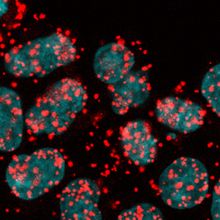Login
Subscribemicrobiology

Gut Bacteria Help T Cells Heal Muscle: Study
Natalia Mesa, PhD | Mar 14, 2023 | 4 min read
Regulatory T cells in the colon travel to muscles to promote wound healing in mice, raising questions about how antibiotics may impact injury recovery.

Garbage to Guts: The Slow-Churn of Plastic Waste
Iris Kulbatski, PhD | Mar 13, 2023 | 4 min read
The winding trail of environmental microplastics is leading researchers to the human digestive ecosystem.

The Scientist Speaks - Ancient Secrets of the Plague
Niki Spahich, PhD | 1 min read
Simon Rasmussen discusses his research tracking the origins of the plague by analyzing ancient DNA.

Mutated Cohesin Throws DNA Splicing out of Whack, Resulting in Cancer
Shafaq Zia | Mar 3, 2023 | 2 min read
Cohesin mutations cause dysregulations in alternative splicing, contributing to tumor initiation and progression, a study finds.

Now AI Can Be Used to Design New Proteins
Kamal Nahas, PhD | Mar 3, 2023 | 4 min read
Machine learning can be harnessed to synthesize artificial light-bearing enzymes that actually work in cells.

Characterizing Proteolysis During SARS-CoV-2 Infection
The Scientist Creative Services Team in collaboration with Thermo Fisher Scientific | 1 min read
Edward Emmott will discuss mass spectrometry approaches to understand proteolysis during viral infection and their use in developing targeted strategies for COVID-19 treatment.

How Genes from Neanderthals Predispose People to Severe COVID-19
Alakananda Dasgupta | Feb 22, 2023 | 4 min read
Researchers dissect the Neanderthal-derived region on chromosome 3 that drives severe COVID-19 to zero in on the key causal variants.

Gut Microbiomes Offer Insights into Chronic Fatigue Syndrome
Shafaq Zia | Feb 21, 2023 | 2 min read
Levels of health-promoting gut bacteria are linked with severity of fatigue symptoms, a study finds.

Treatments for Disease Pandemics
The Scientist | 1 min read
Researchers develop new vaccines and therapeutics to combat the spread of infectious diseases.

Science Falls Behind as Syphilis Stages Another Comeback
Bhargavi Duvvuri, Undark | Feb 21, 2023 | 6 min read
Syphilis is among the oldest known sexually-transmitted infections. Scientists still struggle to detect and treat it.

Bacteria Have Histones After All: Study
Kamal Nahas, PhD | Feb 14, 2023 | 4 min read
Researchers identify hundreds of candidate histone proteins in bacteria, including one with an unusual way of binding to DNA.

Understanding COVID’s Long Game
The Creative Services Team in collaboration with Cayman Chemical | 1 min read
Floyd Chilton and Thomas Bumol shine light on the pathways that SARS-CoV-2 hijacks to cause disease.

Giant Viruses Grew Out of Small Ones: Study
Kamal Nahas, PhD | Feb 13, 2023 | 4 min read
A study employing CRISPR/Cas9 to explore the evolutionary beginnings of some giant viruses finds evidence their large genomes arose from gene duplications.

Drugs Hitch a Ride on Algae for Targeted Delivery
Holly Barker, PhD | Feb 1, 2023 | 3 min read
A new microrobot uses algae to transport antibiotics into the lungs of mice with pneumonia.

Keeping Pace With SARS-CoV-2 Evolution
The Scientist Creative Services Team in collaboration with Thermo Fisher Scientific | 1 min read
Eugene Koonin and Eric Niederkofler discuss novel technologies to improve viral mutation surveillance.

Infographic: Algae Robots Transport Antibiotics to Infected Tissues
Holly Barker, PhD | Feb 1, 2023 | 1 min read
Microscopic algae dotted with drug-filled nanoparticles may offer a more effective means of treatment than traditional delivery methods.

Mitochondrial Metabolism Dictates Neurons’ Growth Rate
Katherine Irving | Jan 30, 2023 | 4 min read
Altering the rate of respiration in mitochondria changes how fast neurons grow, making mouse neurons grow more like human ones and vice versa, a study finds.

Understanding Our Enemies: Identifying Mechanisms of Antibiotic Resistance
The Scientist | 1 min read
Researchers sample and sequence bacteria from biological and environmental sources to learn how to overcome selective pressure

Double Agents: Engineered Bacteria Tackle Pathogenic Biofilms in Mice
Katherine Irving | Jan 26, 2023 | 3 min read
Mycoplasma pneumoniae with pathogenic genes replaced by biofilm-degrading ones enhance survival in a mouse model of ventilator-associated pneumonia.

In Vitro Malaria Sporozoite Production May Lead to Cheaper Vaccines
Katherine Irving | Jan 20, 2023 | 4 min read
A method for culturing the infectious stage of the Plasmodium lifecycle could increase malaria vaccine production efficiency by tenfold, study authors say.